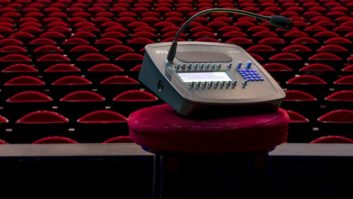
Within the past 10 years there has been a steady convergence of microphone technology and conference electronics. Conferencing has embraced the digital multimedia age, and the integrated systems of boardrooms, courts of law and many other diverse forums have enabled specialist manufacturers to collaborate and expand as never before.
Following the first wave of this evolution, when microphones, electronics and speakers in the conference chain underwent radical re-thinking, the industry is now contemplating the wireless dimension. This involves adding cordless extensions to existing party-line or matrix communications systems in order to provide greater freedom of movement while remaining connected to very wide network infrastructures.
In general, wide frequency response and low distortion became affordable and, although falling short of ‘performance’ levels in the microphone, the new systems benefited from software control of acoustics and speaker management, and from improved transducers.
When it comes to formal audio conferencing, however, there has been some hesitation to embrace wireless technology. Adding wireless systems is an ergonomic rather than an aesthetic option. It’s one of several I/O options to link a conference system to external mixers, PA systems, telephone hybrids or videoconferencing codecs, as well as making it more easily adaptable to an architect’s design or a building’s listed heritage. But misgivings about price, security and battery life have reared time and again, and many issues are still unresolved.
Wi-spy
Wireless technology raises one key concern in conferencing: security. In theory at least, somebody stationed outside with a powerful antenna and a module from the same system could be listening in, even though most scanning techniques can now be blocked if the signal is detected. Addressing this involves expensive R&D for such a low-volume product category, in direct contrast to the more widespread performance market.
On the plus side, spectrum sell-off issues do not impinge: with most systems operating in licence-free ISM bands such as 2.4GHz, the sell-off of the frequencies currently being used for UHF radio microphones doesn’t apply. But the proliferation of WiFi and other technologies in the ISM bands does suggest the increasing likelihood of more competition within buildings for frequencies, with some already predicting stand-offs between AV and IT staff.
Belgium-based Televic has systems in both Strasbourg’s and Brussels’ European Parliament buildings, and Kristoff Henry is product manager for conference technology. He believes that security is less an issue than reliability, especially as consumer technology goes increasingly wireless.
“Consumer wireless will bring down the cost of conference wireless,” he says, “but at the same time delegates are walking in with more and more laptops, mobile phones and other devices. That’s why we’ve come to market relatively late with Confidea, our wireless conference system, because we wanted to get it right. It’s multi-band, so that it can automatically switch from 2.4GHz to 5GHz if it detects interference. There’s a lot more free space in that bandwidth. We’ve also had to be wary of the spectrum sell-off issues because people can be put off by the bad publicity – even though the actual frequencies don’t apply, yet. Basically, air is a shared medium; enclosed wires are not. There will always be something to tackle and, quite possibly, keep driving people towards wired conference solutions.”
Danish Interpretation Systems (DIS) introduced standard IT networking (Cat5) some years ago, enabling users to manage the company’s DCS 6000 system by computer or digital panel and to adapt it easily for many different applications. But despite powerful conference management software, which handles security issues with a tight log-in procedure combined with personal ID chips for the voting units, the system remains a wired solution.
“The disadvantages of wireless are numerous,” says Stuart Cunningham of CUK Audio, the distributor for DIS in the UK. “The first problem is that delegate units are battery powered; this means they require charging regularly which takes up technical staff time. Batteries also need replacing after a few years, meaning the ongoing cost of such systems is greater than a wired system. As well as having a greater ongoing cost, wireless systems are significantly more expensive to purchase than an equivalent wired system.
“There is a demand from the marketplace to push this concept further and make more information – presentations, documents, internet and video – accessible to each delegate, facilitating paperless meetings. Will wireless systems have the bandwidth to be able to deliver this kind of functionality? Is the battery technology to power such devices affordable?”
Embracing wireless
Others are more optimistic. It’s now 10 years since Bosch ushered in the ‘designer’ conference system with the DCN Consentus, followed by the 32-channel wireless interpretation system Integris – which was interference-free thanks to a proprietary ASIC under the hood. A wireless DCN ‘discussion system’ has been developed since, with particular emphasis on wireless interpretation.
“Of course there are some disadvantages of a wireless discussion system, such as batteries,” comments Murat Keskinkilic, Bosch’s product marketing manager for conference, “but I think in the applications where wireless systems are used, the disadvantages are outweighted by the advantages. Flexibility and easiness are the main drivers; the quick set-up and breakdown times make wireless especially interesting in mobile installations, where time plays an important role. Take multipurpose rooms: when using a wireless system, multiple events can take place in sequence, meaning more effective use of space.”
“Wireless technology is appealing to users that don’t need a system installed permanently,” adds Cunningham, “although these users are usually only looking for a basic discussion system. This may be in a boardroom or multifunction space at a town hall. In these instances, the system is packed away after an event and only brought out for the next event. We have, however, found that after considering the pros and cons of wired versus wireless, customers who initially asked about wireless systems actually end up purchasing a wired solution. The current generation of digital conference systems involves no configuration after initial set-up and requires less effort to look after than wireless.”
First-mover advantage
One manufacturer, however, steered into this direction with unfettered confidence and hasn’t looked back. Beyerdynamic’s digital wireless systems were the catalyst, and have taken the company and its leading partners into the much wider markets of installation. For a long time the company’s MCW-D was the market-leading product, a software-controlled system in the mode du jour of complete solutions typified by the service provided by UK distributor Polar Audio. Its licence-free 2.4GHz transmission and reception, together with encrypted wireless security, led to sales into most of the leading banks as well as government bodies, including the UK’s Ministry of Defence and even US government offices.
Matt Nettlefold, product manager for conference systems at Polar Audio, says: “If the client requires the conference system to be portable and moved between rooms or different buildings, wireless is ideal. Beyerdynamic MCW-D conference systems are the most portable systems available today, due to compact antennae that can connect directly to the processor without the need for cables. If a client’s site does not permit intrusive drilling, cable runs, cutting holes and so on due to heritage regulations, the same applies. Anywhere where it’s not physically possible to run cables to and from microphone units and power supplies requires wireless.
“Wireless systems are far more portable than wired systems and can offer greater product longevity, because you don’t have to repeatedly connect and disconnect cables – which can cause damage over time. Some digital wireless systems can actually be more secure than wired systems, due to the advanced encryption that’s used. MCW-D systems offer a very high level of wireless security, with up to 128-bit encryption protocols. They can be installed and used virtually anywhere: licence restrictions in the 2.4GHz area are negligible. And because wireless systems are much easier and quicker to install than wired systems, there is a cost saving to be made by the end user. It’s also possible to update wireless firmware to allow improved functionality in the future, such as extra chairman features, improved voting control and audio improvements via digital EQ.”
Another market leader, Brähler ICS, embraced digital technology with vigour using unobtrusive daisy chains of units, Cat5 cabling and RJ-45 connectors, studio-level DSP technology and zero compression – for at least a decade. But wireless was approached with extreme caution, particularly for larger systems.
Now, according to Brähler ICS UK MD Simon Sainsbury, flexibility between wired and wireless is the key. “If the basic equipment is installed already within the conference centre,” he points out, “the add-on of the delegate units within the conference area is just like ‘snap’. One precondition for that case is the use of plug-and-play technology and a robust and flexible transmission protocol without the elaborate process of setting up the complete system.”
Brähler’s latest statement on the matter is called Digimic, in which a wired system can be upgraded to a wireless system by the simple addition of a wireless docking unit as needed – something that should especially please the rental market.
“With Digimic wireless and the proprietary APRON transmission protocol from Brähler, plug-and-play functionality is available,” adds Sainsbury. “Starting a wireless system right from switch-on has become a very comfortable reality. Wireless is especially important for hotels, due to the tight rental schedules of their function rooms. Nowadays they sell their conference areas with short gaps in between: with a conference during the day and the next event in the evening, the dismantling procedure should not take very long. Central units and antennae are usually in a separate room or in the corner, but public areas need to be cleared very quickly.”
Vote now
So the jury would appear to be out on wireless, although in realistic market terms this means that a balance of the two will prevail as each manufacturer fights its corner and each individual client reaches a verdict. Circumstantial evidence, if it please the court, will be vital…
“The DCN Wireless discussion system is one of a wide range of conference products from Bosch, and it is an important one,” says Keskinkilic. “But the main business in conference is still in wired conference systems, such as DCN Next Generation, and we don’t expect that this will change much in the short term.”
“From what I can see, there doesn’t appear to be a mass migration from wired to wireless, despite more manufacturers offering wireless systems,” adds Cunningham. “I expect wired and wireless systems to coexist in the marketplace for a very long time, with wired systems remaining the preferred choice for larger, more complex and permanently installed systems for the foreseeable future.”
“There is now a very widespread interest in digital wireless conference systems, ranging from local government to business boardrooms,” offers Nettlefold. “Due to this, beyerdynamic has a strong focus on digital wireless product development. Due to advances in technology, better battery life is possible with wireless systems, making them a much more viable option for intensive meeting environments against the traditional wired systems. Beyerdynamic’s new Revoluto system, for example, offers a minimum of 30 hours’ use on a single charge. Revoluto’s line-array microphone technology has also made wireless conference systems a much more attractive proposition for aesthetics-conscious clients. Gone are the days of long gooseneck microphones sticking up everywhere in council chambers and meeting rooms.”
“The decision must always weigh advantages against cost,” concludes Sainsbury. “Is it worth installing wireless? There will always be a price difference between wired and wireless system as wireless technology is more complex. It’s always interesting to have a wireless discussion system, but if simultaneous interpretation is involved does it make sense to have all the functions within one wireless system? There’s the antenna installation, different frequency bands, a separate interpreter booth… In the end these questions must be solved with the help of the consultant or the manufacturer, and will depend on the application.”
Click here for a related case study from Polycom.







